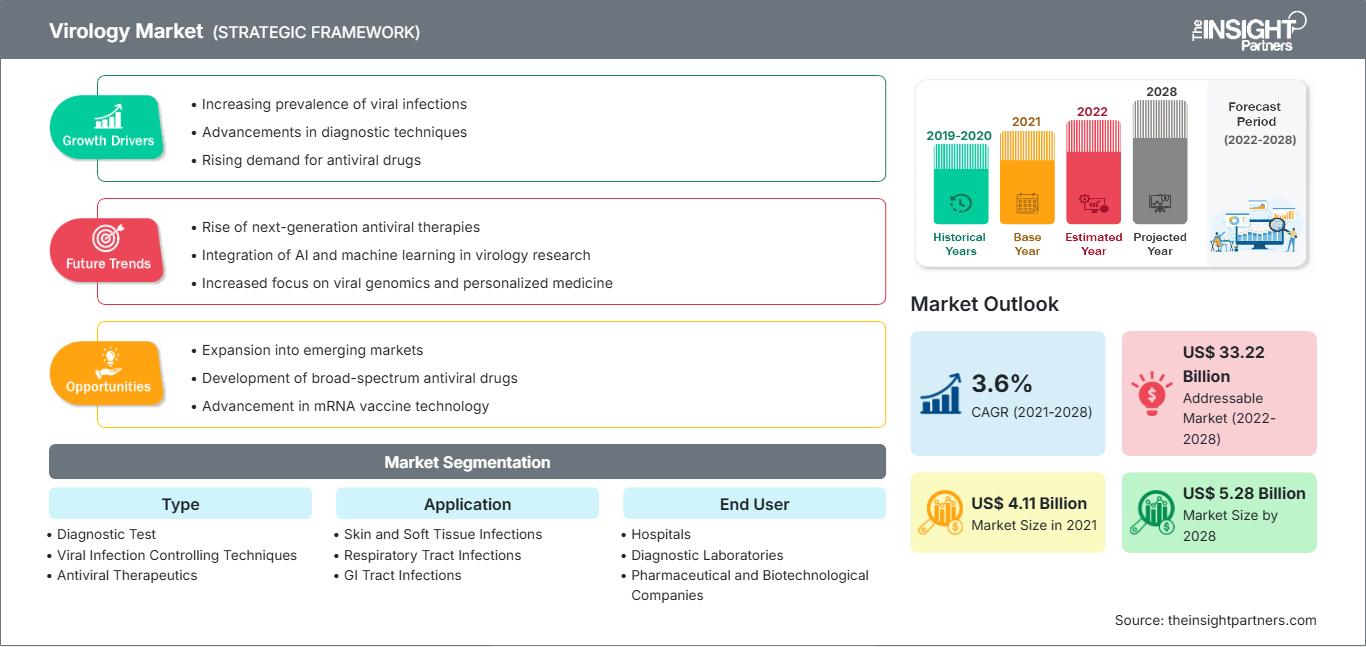Si prevede che il mercato della virologia raggiungerà i 5.276,48 milioni di dollari entro il 2028, rispetto ai 4.108,27 milioni di dollari del 2021; si prevede che registrerà un CAGR del 3,6% dal 2021 al 2028.
- Nell'agosto 2021, la Food and Drug Administration (FDA) statunitense ha approvato il primo vaccino contro il COVID-19, noto come vaccino Pfizer-BioNTech COVID-19. Sarà commercializzato con il nome di ComiRNAty (Koe-mir’-na-tee). Il vaccino è destinato a prevenire la malattia da COVID-19 negli individui dai 16 anni in su. È disponibile anche con autorizzazione all'uso di emergenza (EUA).
- Nell'aprile 2021, CerTest Biotec ha lanciato il suo test diagnostico COVID-19 con marchio CE per il sistema BD MAX.
- Nel maggio 2020, Bio-Rad ha ricevuto l'approvazione della FDA per l'autorizzazione all'uso di emergenza per il test anticorpale totale COVID-19.
- Nel maggio 2020, Aalto Bio Reagents ha lanciato le nuove proteine spike eucariotiche ricombinanti SARS-CoV-2 S1-S2.
Personalizza questo rapporto in base alle tue esigenze
Potrai personalizzare gratuitamente qualsiasi rapporto, comprese parti di questo rapporto, o analisi a livello di paese, pacchetto dati Excel, oltre a usufruire di grandi offerte e sconti per start-up e università
Mercato della virologia: Approfondimenti strategici

- Ottieni le principali tendenze chiave del mercato di questo rapporto.Questo campione GRATUITO includerà l'analisi dei dati, che vanno dalle tendenze di mercato alle stime e alle previsioni.
Potrai personalizzare gratuitamente qualsiasi rapporto, comprese parti di questo rapporto, o analisi a livello di paese, pacchetto dati Excel, oltre a usufruire di grandi offerte e sconti per start-up e università
Mercato della virologia: Approfondimenti strategici

- Ottieni le principali tendenze chiave del mercato di questo rapporto.Questo campione GRATUITO includerà l'analisi dei dati, che vanno dalle tendenze di mercato alle stime e alle previsioni.
Approfondimenti di mercato
La crescente adozione di procedure estetiche mini-invasive e non invasive guida la crescita del mercato della virologia
Mercato della virologia
Le tendenze regionali e i fattori che influenzano il mercato della virologia durante il periodo di previsione sono stati ampiamente spiegati dagli analisti di The Insight Partners. Questa sezione illustra anche i segmenti e la geografia del mercato della virologia in Nord America, Europa, Asia-Pacifico, Medio Oriente e Africa, America meridionale e centrale.
Ambito del rapporto sul mercato della virologia
Densità degli operatori del mercato virologico: comprendere il suo impatto sulle dinamiche aziendali
Il mercato della virologia è in rapida crescita, trainato dalla crescente domanda degli utenti finali, dovuta a fattori quali l'evoluzione delle preferenze dei consumatori, i progressi tecnologici e una maggiore consapevolezza dei benefici del prodotto. Con l'aumento della domanda, le aziende stanno ampliando la propria offerta, innovando per soddisfare le esigenze dei consumatori e sfruttando le tendenze emergenti, alimentando ulteriormente la crescita del mercato.

- Ottieni il Mercato della virologia Panoramica dei principali attori chiave
Approfondimenti basati sulla tipologia
Approfondimenti basati sull'applicazione
Mercato della virologia - Segmentazione
Per tipo
- Test diagnostico
- Test del virus del DNA
- Test del virus dell'RNA
- Altro
- Tecniche di controllo delle infezioni virali
- Profilassi attiva
- Profilassi passiva
- Terapie antivirali
- Agenti virucidi
- Agenti antivirali
- Immunomodulatori
- Interferoni
Per applicazione
- Infezioni della pelle e dei tessuti molli
- Infezioni del tratto respiratorio
- Tratto gastrointestinale Infezioni
- Malattie sessualmente trasmissibili
- Infezioni del tratto urinario
- Altro
Per utente finale
- Ospedali
- Laboratori diagnostici
- Aziende farmaceutiche e biotecnologiche
- Istituti di ricerca e accademici
Per area geografica
- Nord America
- Stati Uniti
- Canada
- Messico
- Europa
- Francia
- Germania
- Italia
- Regno Unito
- Spagna
- Resto d'Europa
- Asia Pacifico
- Cina
- India
- Corea del Sud
- Giappone
- Australia
- Resto dell'APAC
- Medio Oriente e Africa
- Sudafrica
- Arabia Saudita
- Emirati Arabi Uniti
- Resto del MEA
- America meridionale e centrale
- Brasile
- Argentina
- Resto dello SCAM
Profili aziendali
- Abbott
- Johnson & Johnson Services, Inc.
- F. Hoffmann-LA Roche Ltd.
- Thermo Fisher Scientific, Inc.
- Qiagen
- Illumina, Inc.
- Siemens AG
- GlaxoSmithKline Plc
- Gilead Sciences, Inc.
- AbbVie, Inc.nomi di copyright riportati sui rispettivi siti web.
- Analisi storica (2 anni), anno base, previsione (7 anni) con CAGR
- Analisi PEST e SWOT
- Valore/volume delle dimensioni del mercato - Globale, Regionale, Nazionale
- Industria e panorama competitivo
- Set di dati Excel
Report recenti
Testimonianze
Motivo dell'acquisto
- Processo decisionale informato
- Comprensione delle dinamiche di mercato
- Analisi competitiva
- Analisi dei clienti
- Previsioni di mercato
- Mitigazione del rischio
- Pianificazione strategica
- Giustificazione degli investimenti
- Identificazione dei mercati emergenti
- Miglioramento delle strategie di marketing
- Aumento dell'efficienza operativa
- Allineamento alle tendenze normative




















 Ottieni un campione gratuito per - Mercato della virologia
Ottieni un campione gratuito per - Mercato della virologia